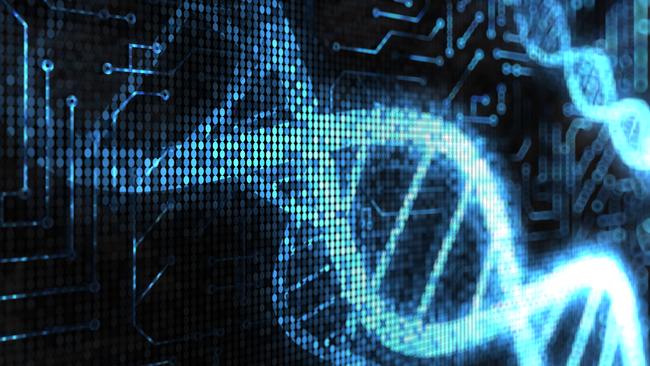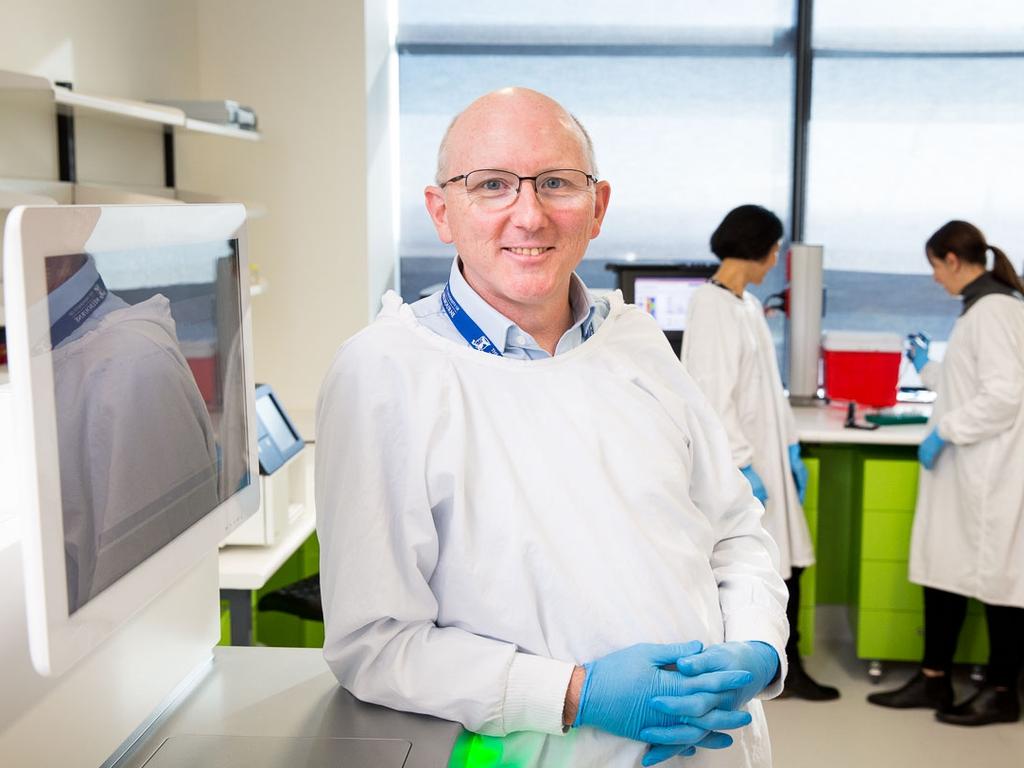AI, genomics and virtual care set to save buckling health systems
In the near future, the way to fight disease will be to prevent it from happening. This is how new technology, from virtual reality to gene splicing, will change our visits to the doctor.

Health systems in Australia and globally face a series of unprecedented challenges that, unchecked, threaten our economic prosperity and way of life. An ageing population, falling birth rates and a wave of chronic disease, teamed with a virtual epidemic of mental health conditions, are putting unprecedented pressure on healthcare resources.
Fortunately, an array of innovative health technologies now offer the prospect of dealing with disease and, most importantly, preventing serious health conditions before they become established. In an era of health workforce shortages and resource constraints, such innovations offer our best way forward to a healthy future.
Orchestrating so much of the healthcare we receive in the future will be artificial intelligence. The number of AI-based health technologies either launched or on the near horizon is staggering. In many routine GP consultations now, for example, the interaction between doctor and patient is captured by AI “scribes”. These smart systems, which handle documentation, guide decision-making and generate correspondence, are written by AI algorithms. While privacy issues loom large and careful management will be required, this has the potential to improve healthcare as doctors’ time is freed up for true patient care rather than administration.
AI already assists medical imaging specialists and pathologists in reaching the diagnoses that inform our treatment. New innovations in AI systems will allow the detection of diseases before they have any clinical effects, facilitating early intervention and preventive strategies to be implemented to protect patients. It’s no exaggeration to say this alone will save many lives.
Doctors and other healthcare workers will have access to innovative AI systems that will provide support in patient care decision-making. These systems will guide management, reduce the risk of inappropriate or ineffective treatments – a major scourge of modern medicine in an era of mass over-prescription – and better establish tests to be performed. This evidence-driven, AI-enhanced approach to patient care will improve efficiency and safety, as well as having economy-wide effects.
When treatment is required, optimal strategies will be determined by doctors in concert with AI outputs. Even surgeons will have their skills enhanced and their judgement augmented by AI systems integrated into robotic surgery tools. Virtual reality systems will improve training and upskilling of healthcare workers, and benefit patients with a range of conditions from chronic pain to movement and sensory disorders.
Another key area in which AI will drive innovation is medical research. Health systems are rich in data and AI will have the capacity to synthesise enormous amounts of patient information to identify new and unsuspected relationships. We are already seeing major global projects in AI-assisted genomics research utilising massive databases of genes. Attention is focused on finding the common genetic causes for rare cancers, but the scope for these projects is vast across an array of morbidities. This AI-driven data crunching will usher in an era in which new treatments, new tests and new ways of treating disease will emerge. Even the existing medical literature will be combed through by AI systems to bring original and exciting insights to existing medical science.
Innovative AI technologies will also drive the development and rollout of virtual care. In the current situation of workforce shortages and under-resourcing across the health sector, AI technologies will expand the reach and scope of care that any individual healthcare worker can provide. This productivity dividend will benefit patients living in regional and remote areas, as well as those with cultural and language barriers to accessing health care.
The synergy between AI and patient care will see autonomous systems interact with patients and triage minor to serious problems remotely. Providing real-time healthcare to people far from clinics and hospitals will become routine, as AI assists doctors located in health hubs to manage large groups of complex patients. One important part of virtual care will be integrating the use of wearable technologies with AI systems.
Advances in intelligent hardware, digital connectivity and data analytics have allowed innovation well beyond our smartwatches and other wearable monitoring systems. New remote monitoring systems will not only record and analyse physiological data in real time, but will also regulate and intervene in disease treatment. Innovative wearable devices will detect not just patient signs, but also laboratory indicators for self-diagnosis and self-monitoring.
A further innovation will be the Internet of Medical Things (IoMT), a transformative shift in healthcare that will change the way patients interact with their own health data. The IoMT will allow seamless connection between patients and medical devices, generating proactive alerts and prompting timely health interventions.
Personalised, predictive remote monitoring systems, guided by AI-powered computing resources, will facilitate truly connected healthcare. The next step in innovation, however, will be moving away from wearable devices to implanted technologies. While “intelligent” systems that detect and correct abnormal heart rhythms, such as implantable defibrillators, have been used in cardiology for some time, newer deep brain implants will define the next generation of innovative medical care.
Huge strides in human medical implants have occurred in recent years and represent the tip of an innovative technological iceberg. Deep brain stimulation systems – part of the field of “electroceuticals” – will be used to modulate the nerve circuits rooted in human brains. They will, in many cases, take over from pharmaceuticals in the management of conditions such as Parkinson’s disease.
On the horizon are even more key roles for deep brain implants, managing common conditions such as severe recurrent headaches, chronic pain and epilepsy. Beyond neurological conditions, the potential exists for further innovation and use of these technologies in the management of psychiatric disorders such as obsessive-compulsive disorder (OCD), severe depression, some addictions and even schizophrenia.
Advances in genomic medicine
At the same time the human genome – the set of instructions coded by our DNA that directs the functioning of our bodies – is yielding secrets that offer a treasure trove of opportunities for innovative medical tests and treatments. Advances in genomic medicine and science – some of the world’s foremost scientists in this field are based in scientific institutes in Australia – have enormous potential, not only in the diagnosis of established diseases, but in identifying the risks we carry for future ill health as well. This genomic information will allow early intervention and guide the most precise treatments.
Genomic technologies now allow the identification of specific disease-causing genes, such as BRCA mutations, as well as clusters of genetic information that predispose us to ill health. These genetic clues allow the identification of people at risk of conditions as diverse as coronary artery heart disease, adult-onset diabetes and inflammatory bowel disease. Understanding risks allows patients and their doctors to plan preventive or screening programs to minimise risk.
Genomics will guide more appropriate, effective and precise pharmaceutical prescriptions, too. Innovations in genomic medicine now allow healthcare teams to predict an individual patient’s response to treatment and, importantly, to tailor treatment with precision. “Precision medicine” is developing rapidly, allowing improvements in the treatment of diseases as diverse as cancer, mental health and neurological conditions.
Understanding the genetic blueprints each of us carry in every cell is important, but the opportunity to understand our individual genomes does not help in the management of many conditions. New innovations are allowing scientists to move beyond simply finding and adapting to the genetic hand we are dealt.
The ability for scientists to edit our genome – to remove genes that cause disease and replace them with normally functioning genetic material – is proceeding at a dizzying pace. Gene editing technologies such as the CRISPR system (Clustered Regularly Interspaced Short Palindromic Repeats, which are the hallmark of a bacterial defence system that forms the basis for a type of genome editing technology) and a newer suite of related innovations allow defects to be identified with precision among the three billion molecules in a typical strand of human DNA.
The DNA in human cells can be unwound, the errant gene cut out using the CRISPR “scissors”, and the DNA spliced back together. The technology also allows healthy replacement genes to be patched back into our DNA, restoring normal function to cells. No longer will humans have to manage the genetic hand they’ve been dealt. It also has the potential to treat some very serious health conditions. Blood cells can be taken from the body, have their DNA edited, then be reintroduced to multiply and replace unhealthy cells. These innovative treatments can be used to treat common benign conditions such as thalassaemia and sickle cell disease.
Another role for gene editing will be in treating blood and other cancers. The genes of human immune cells can be edited to specifically target cancerous cells in common blood cancers such as lymphoma.
Innovative gene editing techniques are being employed to deliver healthy cells beyond the bloodstream and into our body’s organs. This offers the promise of replacing diseased cells in serious conditions ranging from muscular dystrophy to types of blindness, and even liver conditions causing high cholesterol. Experiments are already underway using cells from the pancreas to begin producing insulin again in people with diabetes, doing away with the need for insulin injections.
Beyond our DNA, innovative mRNA technologies – familiar to us from the mRNA vaccines for Covid-19 – will transform the treatment of a range of conditions thought to be incurable. These advances have enabled not only vaccine development but also the production of almost any protein within the body by using mRNA to deliver precisely around our bodies. Cancer vaccines based on mRNA technologies are already proceeding apace. But beyond cancer, these new precise therapies will enable management of genetic, infectious and other serious chronic conditions.
Moving beyond our own bodies, our microbiomes – increasingly understood to be vital to both physical and mental health – will continue to provide a rich source of information about our health and wellbeing. Innovative AI-driven technologies will identify the patterns of microbes that live on and within our bodies and discern links between our individual microbiome and specific health conditions, with that information used to personalise preventive and therapeutic managements.
New and innovative technologies and treatments, from the genetic to microbiological, are set to transform health care over the next decade. As our health systems deal with workforce and resource constraints, and an ageing population is affected by greater levels of physical and mental health challenges, AI-driven innovations will deliver more precise preventive and curative treatments, many never envisioned until now.





To join the conversation, please log in. Don't have an account? Register
Join the conversation, you are commenting as Logout